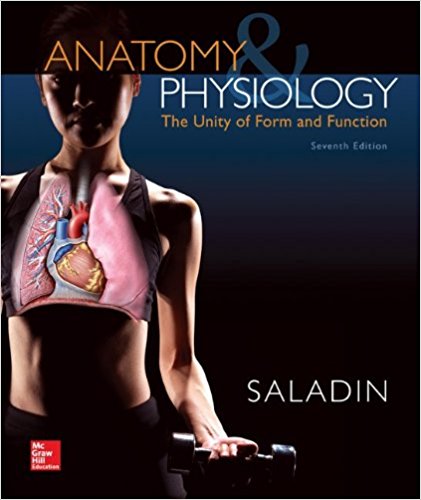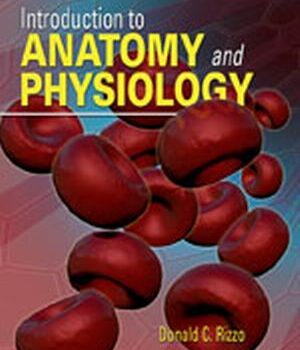Description
Test Bank For Anatomy And Physiology The Unity Of Form And Function Saladin 7th Edition
Chapter 02 The Chemistry of Life
True / False Questions
1. Minerals are organic elements extracted from the soil by plants.
2. Molecules composed of two or more atoms are called compounds.
3. Hydrogen, deuterium, and tritium are three isotopes of hydrogen.
4. Potassium, sodium, and chlorine are trace elements.
5. Ionic bonds break apart in water more easily than covalent bonds do.
6. A solution is a mixture of two or more substances that are physically blended but not chemically combined.
7. The pH of blood plasma is approximately 7.4, which is slightly acidic.
8. The high heat capacity of water makes it a very ineffective coolant.
9. In an exchange reaction, covalent bonds are broken and new covalent bonds are formed.
10. Chemical reactions in which larger molecules are broken down into smaller ones are called catabolic reactions.
11. The opposite of a dehydration synthesis reaction is a hydrolysis reaction.
12. Unsaturated fatty acids have as much hydrogen as they can carry.
13. A dipeptide is a molecule with two peptide bonds.
14. All amino acids have both a carboxyl group and an amino group attached to a central carbon.
15. ATP is the body’s most important form of long-term energy storage.
Multiple Choice Questions
16. The most abundant element in the human body, by weight, is __________.
A. nitrogen
B. hydrogen
C. carbon
D. oxygen
E. calcium
17. Sodium has an atomic number of 11 and an atomic mass of 23. Sodium has __________.
A. 12 neutrons and 11 protons
B. 12 protons and 11 neutrons
C. 12 electrons and 11 neutrons
D. 12 protons and 11 electrons
E. 12 electrons and 11 protons
18. The chemical properties of an atom are determined by its __________.
A. protons
B. electrons
C. neutrons
D. protons and neutrons
E. particles
19. Na (atomic no. 11) reacts with Cl (atomic no. 17) to become stable. In the reaction, Na will ____________, while Cl will ____________.
A. accept one electron; give up one electron
B. give up one proton; accept one proton
C. share one electron with chlorine; share one electron with sodium
D. become an anion; become a cation
E. give up one electron; accept one electron
20. Oxygen has an atomic number of 8 and an atomic mass of 16. How many valence electrons does it have?
A. 2
B. 4
C. 6
D. 8
E. 16
21. Oxygen has an atomic number of eight. When two oxygen atoms come together, they form a(n) __________ bond.
A. hydrogen
B. nonpolar covalent
C. polar covalent
D. ionic
E. Van der Waals
22. When table salt, sodium chloride (NaCl), is placed in water __________.
A. Na+ and Cl- form ionic bonds with each other
B. Na+ and Cl- form polar covalent bonds with each other
C. Na+ and Cl- form hydrogen bonds with water
D. Ionic bonds between Na+ and Cl- are broken
E. Na+ and Cl- become separated by their Van der Waals forces
23. The bonding properties of an atom are determined by its __________.
A. electrons
B. protons
C. positrons
D. neutrons
E. photons
24. What type of bond attracts one water molecule to another?
A. An ionic bond
B. A peptide bond
C. A hydrogen bond
D. A covalent bond
E. A hydrolytic bond
Check All That Apply Questions
25. Which of these is a cation? Check all that apply.
_____ O2
__X__ K+
__X__ Na+
__X__ Ca2+
_____ Cl-
Multiple Choice Questions
26. __________ account for 98.5% of the body’s weight.
A. Carbon, oxygen, hydrogen, sodium, potassium, and chlorine
B. Carbon, oxygen, iron, sodium, potassium, and chlorine
C. Carbon, nitrogen, hydrogen, sodium, potassium, and chlorine
D. Carbon, oxygen, hydrogen, nitrogen, sodium, and potassium
E. Carbon, oxygen, hydrogen, nitrogen, calcium, and phosphorus
27. __________ differ from one another in their number of neutrons and atomic mass.
A. Cations
B. Anions
C. Isotopes
D. Electrolytes
E. Free radicals
28. When jumping into water you notice resistance. This resistance is caused by water’s __________.
A. adhesiveness
B. cohesiveness
C. hydrophobic tension
D. hydrophilic tension
E. osmotic equilibrium
29. Which of these is hydrophobic?
A. Glucose
B. K+
C. Cl-
D. Water
E. Fat
30. Blood contains NaCl, protein, and cells. The NaCl is in a(n) __________, the protein is in a(n) __________, and the cells are in a __________.
A. emulsion; solution; suspension
B. solvent; emulsion; colloid
C. colloid; suspension; solution
D. suspension; colloid; solution
E. solution; colloid; suspension





Be the first to review “Test Bank For Anatomy And Physiology The Unity Of Form And Function Saladin 7th Edition”